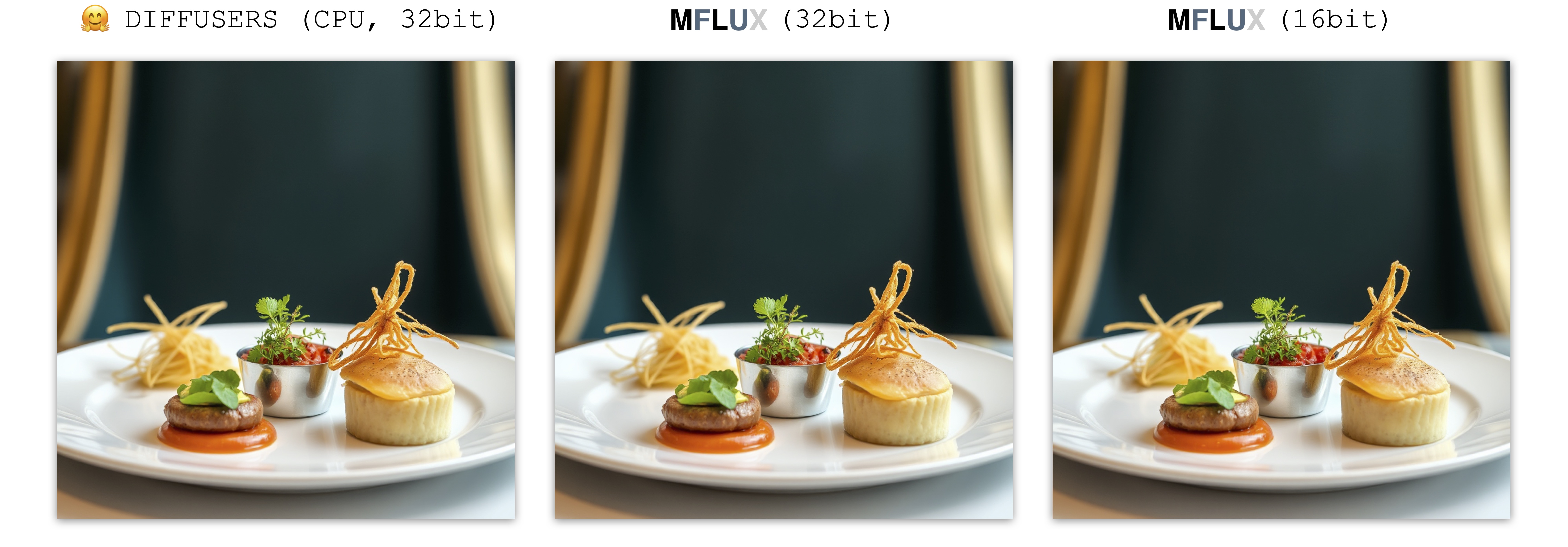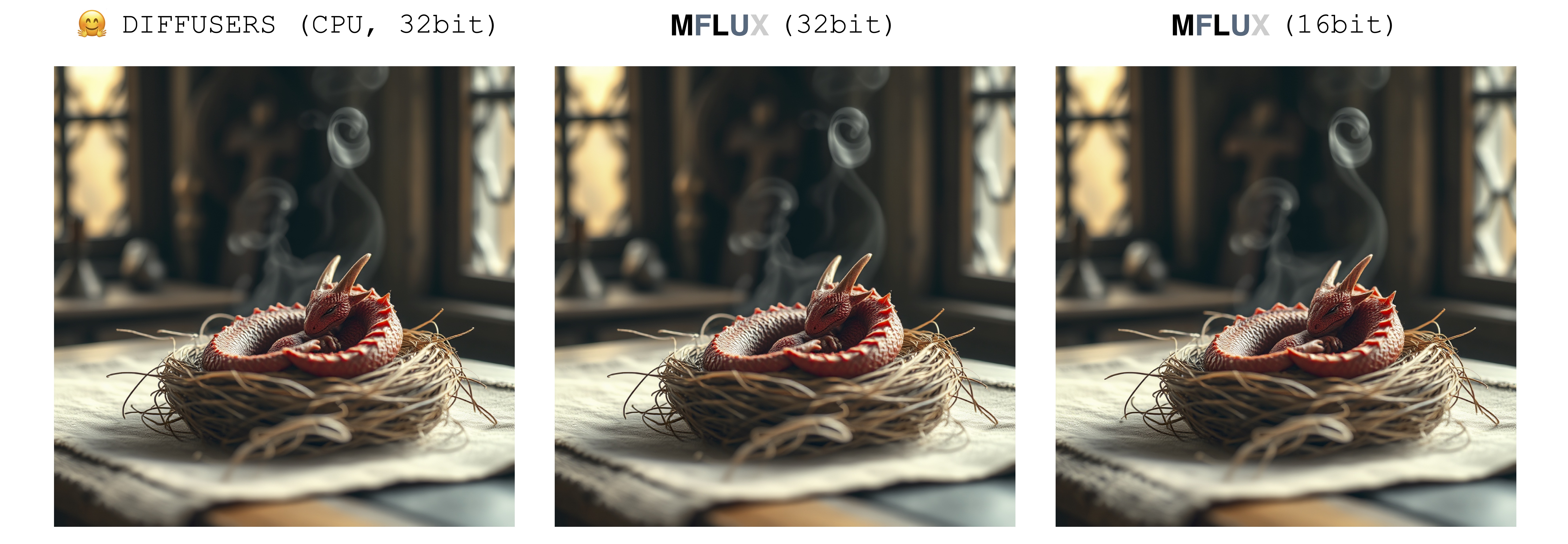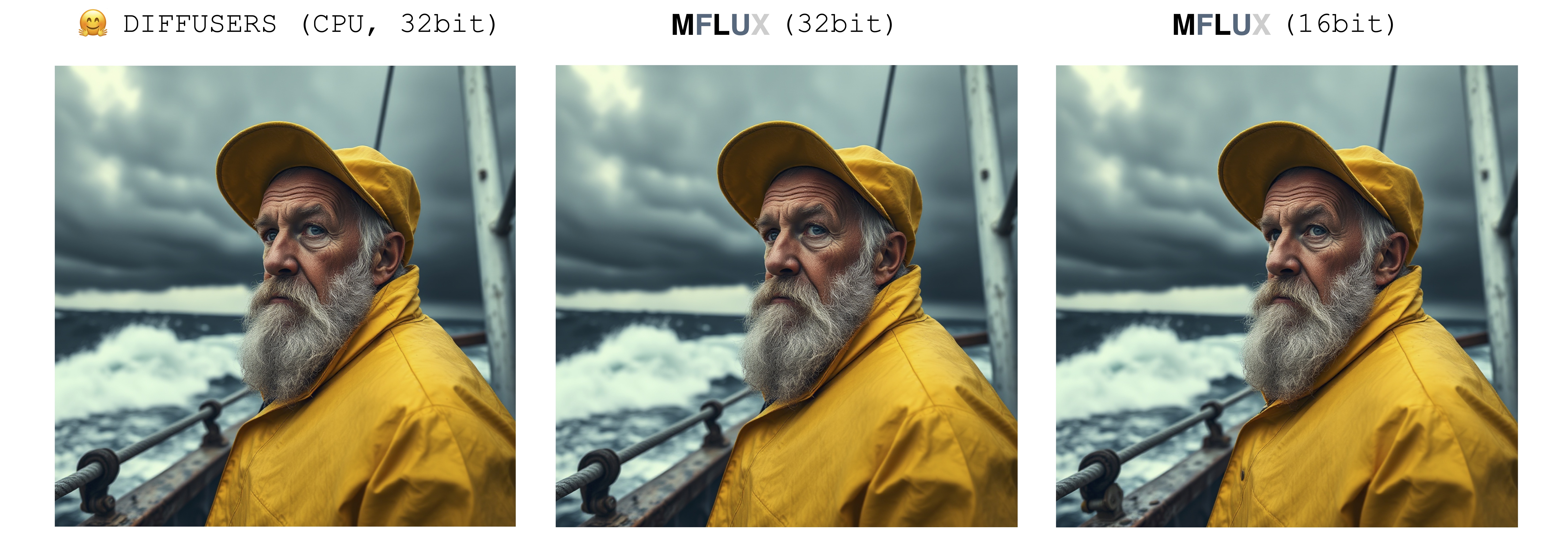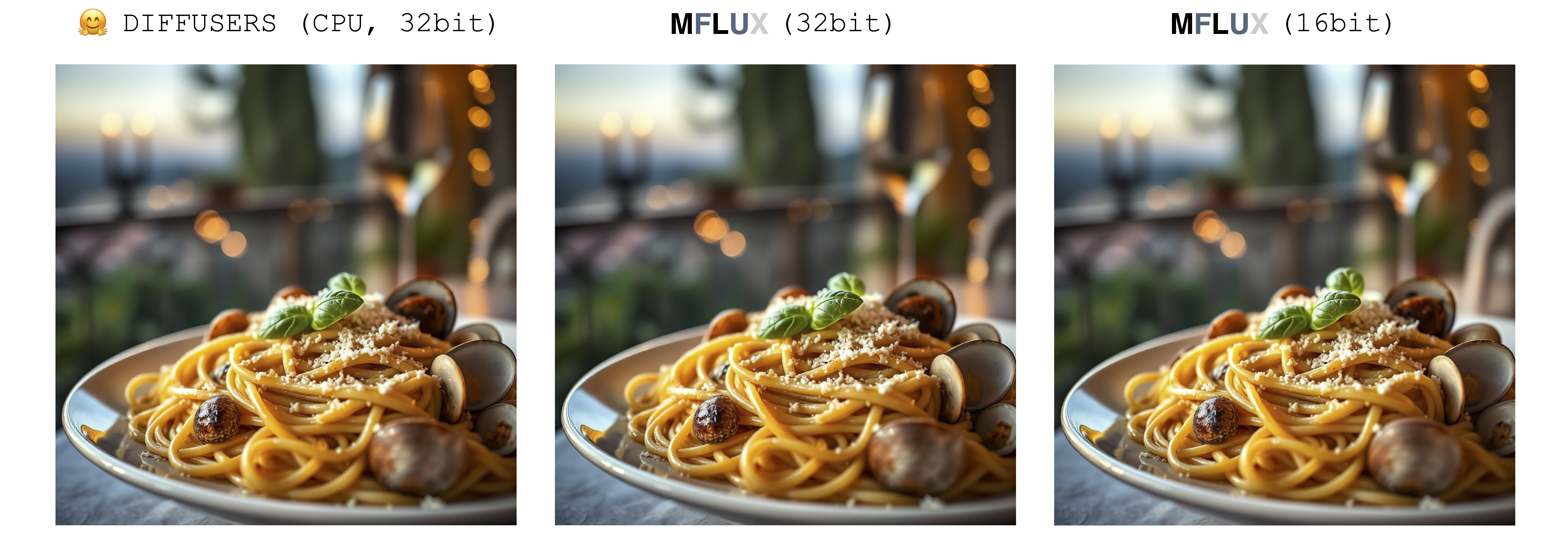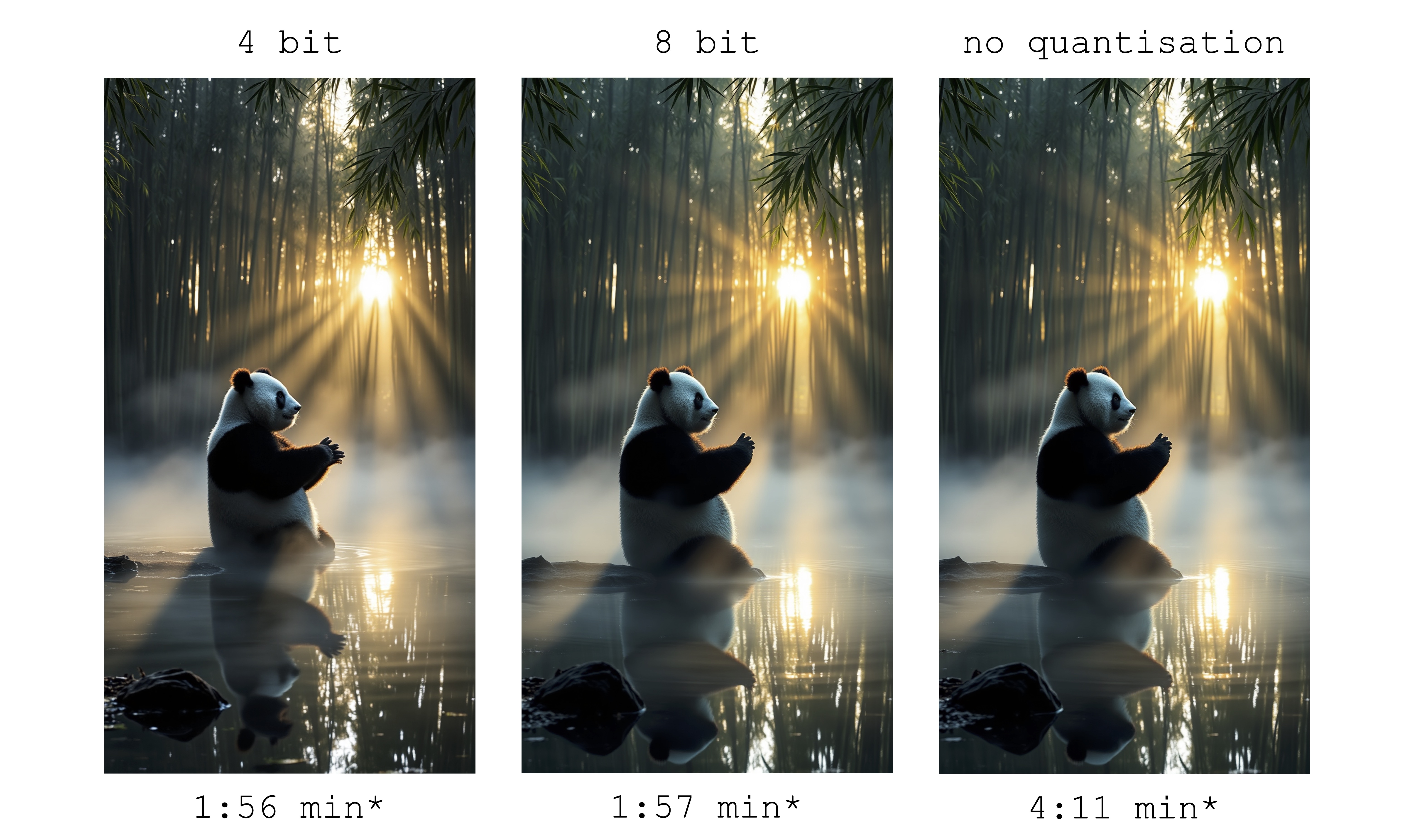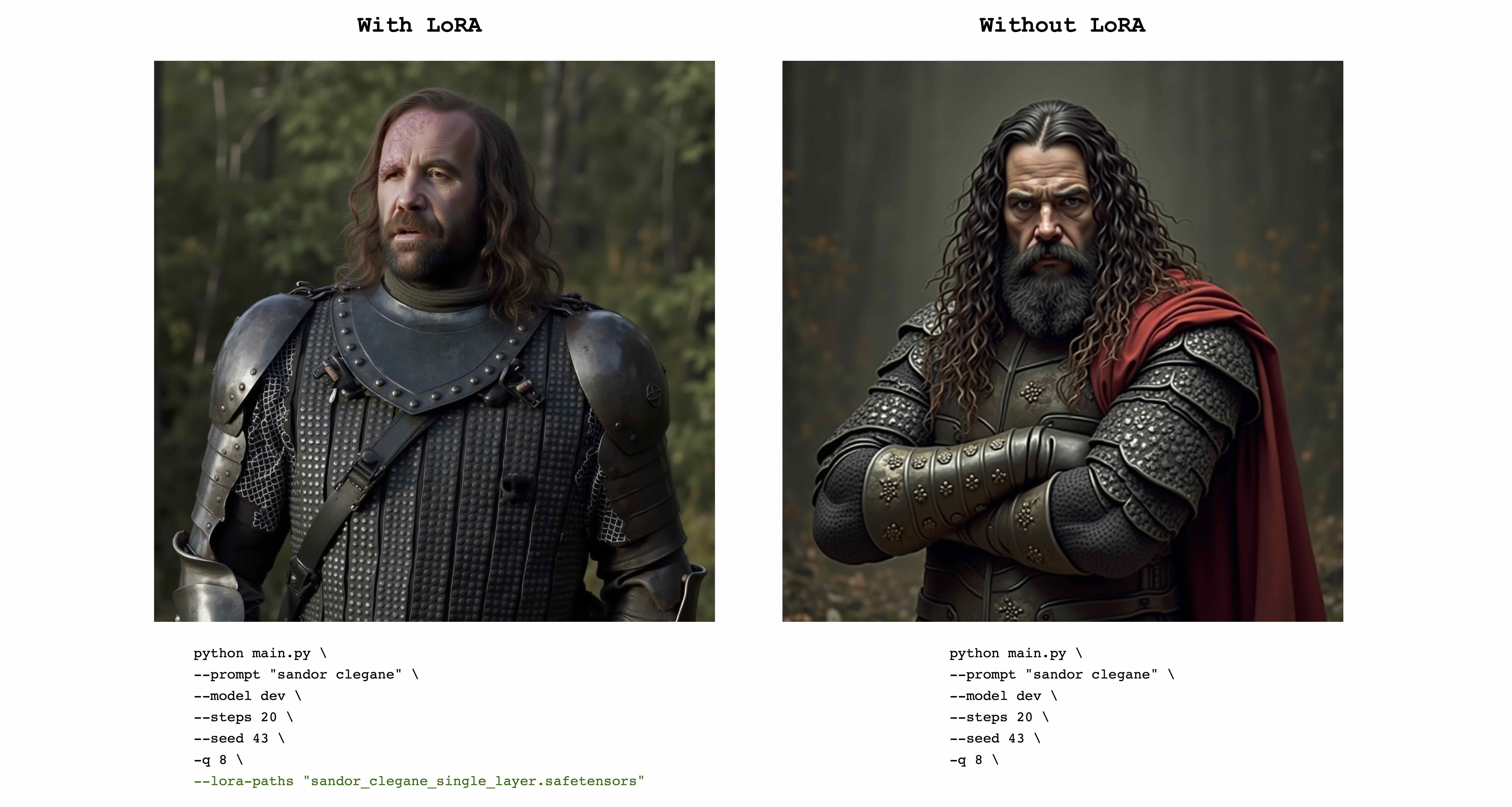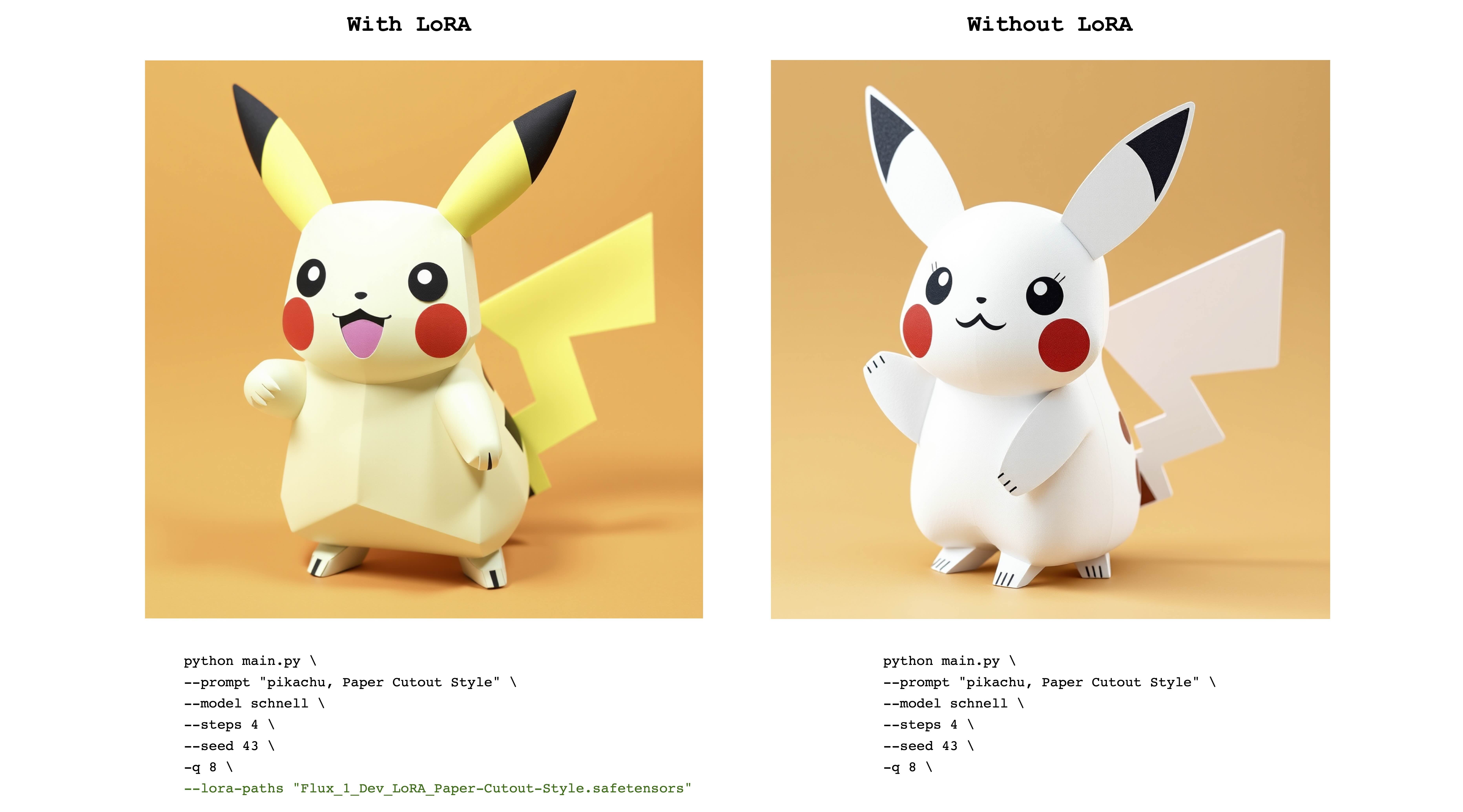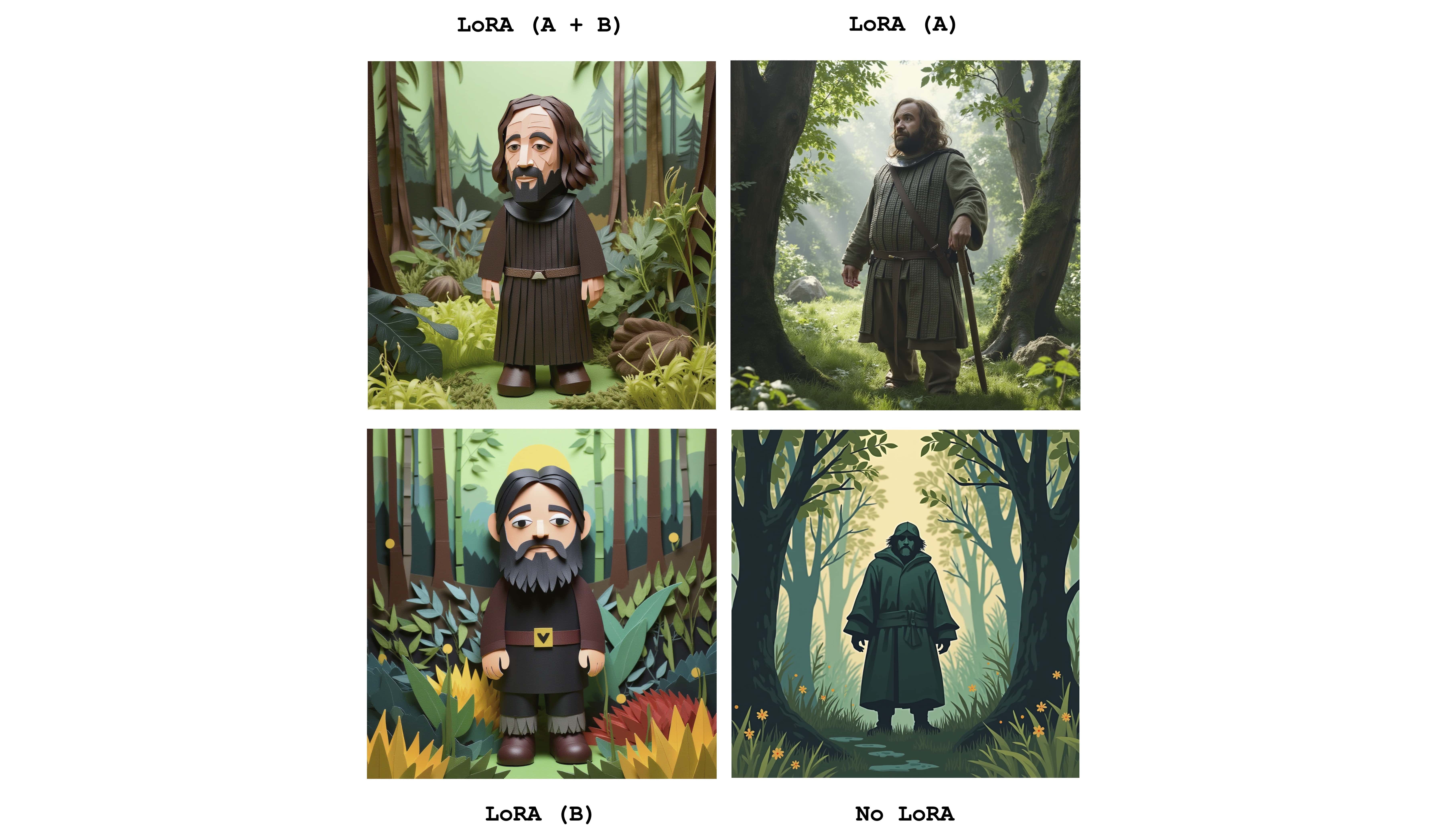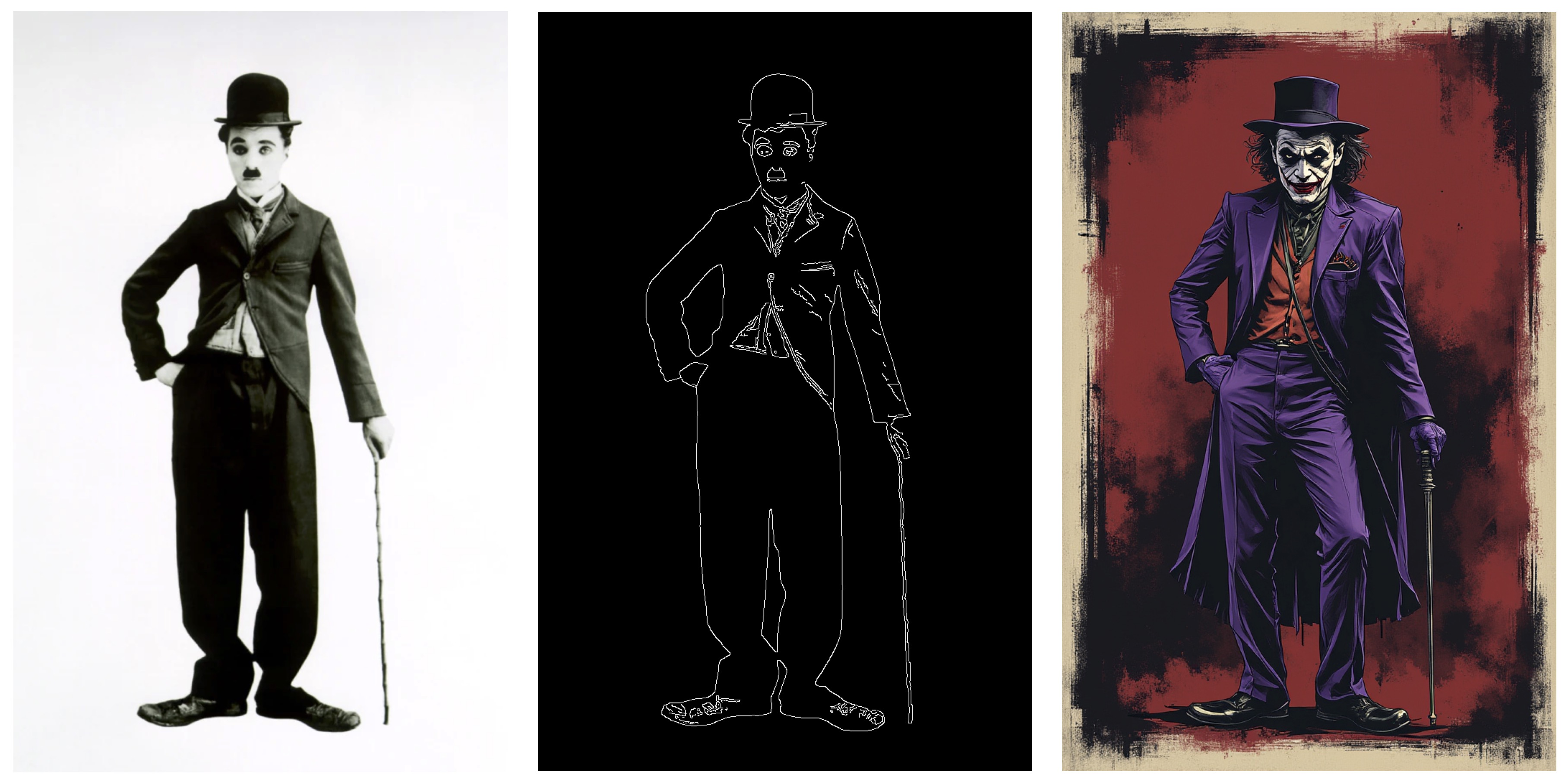 A MLX port of FLUX based on the Huggingface Diffusers implementation.
A MLX port of FLUX based on the Huggingface Diffusers implementation.
Run the powerful FLUX models from Black Forest Labs locally on your Mac!
- Philosophy
- 💿 Installation
- 🖼️ Generating an image
- ⏱️ Image generation speed (updated)
↔️ Equivalent to Diffusers implementation- 🗜️ Quantization
- 💽 Running a non-quantized model directly from disk
- 🎨 Image-to-Image
- 🔌 LoRA
- 🕹️ Controlnet
- 🚧 Current limitations
- 💡Workflow tips
- ✅ TODO
- 🔬 Cool research / features to support
- 🌱 Related projects
- License
MFLUX is a line-by-line port of the FLUX implementation in the Huggingface Diffusers library to Apple MLX. MFLUX is purposefully kept minimal and explicit - Network architectures are hardcoded and no config files are used except for the tokenizers. The aim is to have a tiny codebase with the single purpose of expressing these models (thereby avoiding too many abstractions). While MFLUX priorities readability over generality and performance, it can still be quite fast, and even faster quantized.
All models are implemented from scratch in MLX and only the tokenizers are used via the Huggingface Transformers library. Other than that, there are only minimal dependencies like Numpy and Pillow for simple image post-processing.
For users, the easiest way to install MFLUX is to use uv tool: If you have installed uv, simply:
uv tool install --upgrade mfluxto get the mflux-generate and related command line executables. You can skip to the usage guides below.
For Python 3.13 dev preview
The T5 encoder is dependent on sentencepiece, which does not have a installable wheel artifact for Python 3.13 as of Nov 2024. Until Google publishes a 3.13 wheel, you need to build your own wheel with official build instructions or for your convenience use a .whl pre-built by contributor @anthonywu. The steps below should work for most developers though your system may vary.
uv venv --python 3.13
python -V # e.g. Python 3.13.0rc2
source .venv/bin/activate
# for your convenience, you can use the contributor wheel
uv pip install https://github.com/anthonywu/sentencepiece/releases/download/0.2.1-py13dev/sentencepiece-0.2.1-cp313-cp313-macosx_11_0_arm64.whl
# enable the pytorch nightly
uv pip install --pre --extra-index-url https://download.pytorch.org/whl/nightly -e .For the classic way to create a user virtual environment:
mkdir -p mflux && cd mflux && python3 -m venv .venv && source .venv/bin/activate
This creates and activates a virtual environment in the mflux folder. After that, install MFLUX via pip:
pip install -U mflux
For contributors (click to expand)
- Clone the repo:
git clone git@github.com:filipstrand/mflux.git- Install the application
make install- To run the test suite
make test- Follow format and lint checks prior to submitting Pull Requests. The recommended
make lintandmake formatinstalls and usesruff. You can setup your editor/IDE to lint/format automatically, or use our providedmakehelpers:
make format- formats your codemake lint- shows your lint errors and warnings, but does not auto fixmake check- viapre-commithooks, formats your code and attempts to auto fix lint errors- consult official
ruffdocumentation on advanced usages
Run the command mflux-generate by specifying a prompt and the model and some optional arguments. For example, here we use a quantized version of the schnell model for 2 steps:
mflux-generate --model schnell --prompt "Luxury food photograph" --steps 2 --seed 2 -q 8This example uses the more powerful dev model with 25 time steps:
mflux-generate --model dev --prompt "Luxury food photograph" --steps 25 --seed 2 -q 8By default, model files are downloaded to the .cache folder within your home directory. For example, in my setup, the path looks like this:
/Users/filipstrand/.cache/huggingface/hub/models--black-forest-labs--FLUX.1-dev
To change this default behavior, you can do so by modifying the HF_HOME environment variable. For more details on how to adjust this setting, please refer to the Hugging Face documentation.
-
--prompt(required,str): Text description of the image to generate. -
--modelor-m(required,str): Model to use for generation ("schnell"or"dev"). -
--output(optional,str, default:"image.png"): Output image filename. -
--seed(optional,int, default:None): Seed for random number generation. Default is time-based. -
--height(optional,int, default:1024): Height of the output image in pixels. -
--width(optional,int, default:1024): Width of the output image in pixels. -
--steps(optional,int, default:4): Number of inference steps. -
--guidance(optional,float, default:3.5): Guidance scale (only used for"dev"model). -
--path(optional,str, default:None): Path to a local model on disk. -
--quantizeor-q(optional,int, default:None): Quantization (choose between4or8). -
--lora-paths(optional,[str], default:None): The paths to the LoRA weights. -
--lora-scales(optional,[float], default:None): The scale for each respective LoRA (will default to1.0if not specified and only one LoRA weight is loaded.) -
--metadata(optional): Exports a.jsonfile containing the metadata for the image with the same name. (Even without this flag, the image metadata is saved and can be viewed usingexiftool image.png) -
--controlnet-image-path(required,str): Path to the local image used by ControlNet to guide output generation. -
--controlnet-strength(optional,float, default:0.4): Degree of influence the control image has on the output. Ranges from0.0(no influence) to1.0(full influence). -
--controlnet-save-canny(optional, bool, default: False): If set, saves the Canny edge detection reference image used by ControlNet. -
--init-image-path(optional,str, default:None): Local path to the initial image for image-to-image generation. -
--init-image-strength(optional,float, default:0.4): Controls how strongly the initial image influences the output image. A value of0.0means no influence. (Default is0.4) -
--config-from-metadataor-C(optional,str): [EXPERIMENTAL] Path to a prior file saved via--metadata, or a compatible handcrafted config file adhering to the expected args schema.
parameters supported by config files
- all config properties are optional and applied to the image generation if applicable
- invalid or incompatible properties will be ignored
{
"$schema": "http://json-schema.org/draft-07/schema#",
"type": "object",
"properties": {
"seed": {
"type": ["integer", "null"]
},
"steps": {
"type": ["integer", "null"]
},
"guidance": {
"type": ["number", "null"]
},
"quantize": {
"type": ["null", "string"]
},
"lora_paths": {
"type": ["array", "null"],
"items": {
"type": "string"
}
},
"lora_scales": {
"type": ["array", "null"],
"items": {
"type": "number"
}
},
"prompt": {
"type": ["string", "null"]
}
}
}{
"model": "dev",
"seed": 42,
"steps": 8,
"guidance": 3.0,
"quantize": 4,
"lora_paths": [
"/some/path1/to/subject.safetensors",
"/some/path2/to/style.safetensors"
],
"lora_scales": [
0.8,
0.4
],
"prompt": "award winning modern art, MOMA"
}Or, with the correct python environment active, create and run a separate script like the following:
from mflux import Flux1, Config
# Load the model
flux = Flux1.from_alias(
alias="schnell", # "schnell" or "dev"
quantize=8, # 4 or 8
)
# Generate an image
image = flux.generate_image(
seed=2,
prompt="Luxury food photograph",
config=Config(
num_inference_steps=2, # "schnell" works well with 2-4 steps, "dev" works well with 20-25 steps
height=1024,
width=1024,
)
)
image.save(path="image.png")For more options on how to configure MFLUX, please see generate.py.
These numbers are based on the non-quantized schnell model, with the configuration provided in the code snippet below.
To time your machine, run the following:
time mflux-generate \
--prompt "Luxury food photograph" \
--model schnell \
--steps 2 \
--seed 2 \
--height 1024 \
--width 1024To find out the spec of your machine (including number of CPU cores, GPU cores, and memory, run the following command:
system_profiler SPHardwareDataType SPDisplaysDataType| Device | M-series | User | Reported Time | Notes |
|---|---|---|---|---|
| Mac Studio | 2023 M2 Ultra | @awni | <15s | |
| Macbook Pro | 2024 M4 Max (128GB) | @ivanfioravanti | ~19s | |
| Macbook Pro | 2023 M3 Max | @karpathy | ~20s | |
| - | 2023 M2 Max (96GB) | @explorigin | ~25s | |
| Mac Mini | 2024 M4 Pro (64GB) | @Stoobs | ~34s | |
| Mac Mini | 2023 M2 Pro (32GB) | @leekichko | ~54s | |
| - | 2022 M1 MAX (64GB) | @BosseParra | ~55s | |
| Macbook Pro | 2023 M2 Max (32GB) | @filipstrand | ~70s | |
| - | 2023 M3 Pro (36GB) | @kush-gupt | ~80s | |
| Macbook Pro | 2021 M1 Pro (32GB) | @filipstrand | ~160s | |
| - | 2021 M1 Pro (16GB) | @qw-in | ~175s | Might freeze your mac |
| Macbook Air | 2020 M1 (8GB) | @mbvillaverde | ~335s | With resolution 512 x 512 |
Note that these numbers includes starting the application from scratch, which means doing model i/o, setting/quantizing weights etc.
If we assume that the model is already loaded, you can inspect the image metadata using exiftool image.png and see the total duration of the denoising loop (excluding text embedding).
These benchmarks are not very scientific and is only intended to give ballpark numbers. They were performed during different times with different MFLUX and MLX-versions etc. Additional hardware information such as number of GPU cores, Mac device etc. are not always known.
There is only a single source of randomness when generating an image: The initial latent array.
In this implementation, this initial latent is fully deterministically controlled by the input seed parameter.
However, if we were to import a fixed instance of this latent array saved from the Diffusers implementation, then MFLUX will produce an identical image to the Diffusers implementation (assuming a fixed prompt and using the default parameter settings in the Diffusers setup).
The images below illustrate this equivalence. In all cases the Schnell model was run for 2 time steps. The Diffusers implementation ran in CPU mode. The precision for MFLUX can be set in the Config class. There is typically a noticeable but very small difference in the final image when switching between 16bit and 32bit precision.
Luxury food photograph
detailed cinematic dof render of an old dusty detailed CRT monitor on a wooden desk in a dim room with items around, messy dirty room. On the screen are the letters "FLUX" glowing softly. High detail hard surface render
photorealistic, lotr, A tiny red dragon curled up asleep inside a nest, (Soft Focus) , (f_stop 2.8) , (focal_length 50mm) macro lens f/2. 8, medieval wizard table, (pastel) colors, (cozy) morning light filtering through a nearby window, (whimsical) steam shapes, captured with a (Canon EOS R5) , highlighting (serene) comfort, medieval, dnd, rpg, 3d, 16K, 8K
A weathered fisherman in his early 60s stands on the deck of his boat, gazing out at a stormy sea. He has a thick, salt-and-pepper beard, deep-set blue eyes, and skin tanned and creased from years of sun exposure. He's wearing a yellow raincoat and hat, with water droplets clinging to the fabric. Behind him, dark clouds loom ominously, and waves crash against the side of the boat. The overall atmosphere is one of tension and respect for the power of nature.
Luxury food photograph of an italian Linguine pasta alle vongole dish with lots of clams. It has perfect lighting and a cozy background with big bokeh and shallow depth of field. The mood is a sunset balcony in tuscany. The photo is taken from the side of the plate. The pasta is shiny with sprinkled parmesan cheese and basil leaves on top. The scene is complemented by a warm, inviting light that highlights the textures and colors of the ingredients, giving it an appetizing and elegant look.
MFLUX supports running FLUX in 4-bit or 8-bit quantized mode. Running a quantized version can greatly speed up the generation process and reduce the memory consumption by several gigabytes. Quantized models also take up less disk space.
mflux-generate \
--model schnell \
--steps 2 \
--seed 2 \
--quantize 8 \
--height 1920 \
--width 1024 \
--prompt "Tranquil pond in a bamboo forest at dawn, the sun is barely starting to peak over the horizon, panda practices Tai Chi near the edge of the pond, atmospheric perspective through the mist of morning dew, sunbeams, its movements are graceful and fluid — creating a sense of harmony and balance, the pond’s calm waters reflecting the scene, inviting a sense of meditation and connection with nature, style of Howard Terpning and Jessica Rossier"In this example, weights are quantized at runtime - this is convenient if you don't want to save a quantized copy of the weights to disk, but still want to benefit from the potential speedup and RAM reduction quantization might bring.
By selecting the --quantize or -q flag to be 4, 8, or removing it entirely, we get all 3 images above. As can be seen, there is very little difference between the images (especially between the 8-bit, and the non-quantized result).
Image generation times in this example are based on a 2021 M1 Pro (32GB) machine. Even though the images are almost identical, there is a ~2x speedup by
running the 8-bit quantized version on this particular machine. Unlike the non-quantized version, for the 8-bit version the swap memory usage is drastically reduced and GPU utilization is close to 100% during the whole generation. Results here can vary across different machines.
The model sizes for both schnell and dev at various quantization levels are as follows:
| 4 bit | 8 bit | Original (16 bit) |
|---|---|---|
| 9.85GB | 18.16GB | 33.73GB |
The reason weights sizes are not fully cut in half is because a small number of weights are not quantized and kept at full precision.
To save a local copy of the quantized weights, run the mflux-save command like so:
mflux-save \
--path "/Users/filipstrand/Desktop/schnell_8bit" \
--model schnell \
--quantize 8Note that when saving a quantized version, you will need the original huggingface weights.
It is also possible to specify LoRA adapters when saving the model, e.g
mflux-save \
--path "/Users/filipstrand/Desktop/schnell_8bit" \
--model schnell \
--quantize 8 \
--lora-paths "/path/to/lora.safetensors" \
--lora-scales 0.7When generating images with a model like this, no LoRA adapter is needed to be specified since it is already baked into the saved quantized weights.
To generate a new image from the quantized model, simply provide a --path to where it was saved:
mflux-generate \
--path "/Users/filipstrand/Desktop/schnell_8bit" \
--model schnell \
--steps 2 \
--seed 2 \
--height 1920 \
--width 1024 \
--prompt "Tranquil pond in a bamboo forest at dawn, the sun is barely starting to peak over the horizon, panda practices Tai Chi near the edge of the pond, atmospheric perspective through the mist of morning dew, sunbeams, its movements are graceful and fluid — creating a sense of harmony and balance, the pond’s calm waters reflecting the scene, inviting a sense of meditation and connection with nature, style of Howard Terpning and Jessica Rossier"Note: When loading a quantized model from disk, there is no need to pass in -q flag, since we can infer this from the weight metadata.
Also Note: Once we have a local model (quantized or not) specified via the --path argument, the huggingface cache models are not required to launch the model.
In other words, you can reclaim the 34GB diskspace (per model) by deleting the full 16-bit model from the Huggingface cache if you choose.
If you don't want to download the full models and quantize them yourself, the 4-bit weights are available here for a direct download:
MFLUX also supports running a non-quantized model directly from a custom location.
In the example below, the model is placed in /Users/filipstrand/Desktop/schnell:
mflux-generate \
--path "/Users/filipstrand/Desktop/schnell" \
--model schnell \
--steps 2 \
--seed 2 \
--prompt "Luxury food photograph"Note that the --model flag must be set when loading a model from disk.
Also note that unlike when using the typical alias way of initializing the model (which internally handles that the required resources are downloaded),
when loading a model directly from disk, we require the downloaded models to look like the following:
.
├── text_encoder
│ └── model.safetensors
├── text_encoder_2
│ ├── model-00001-of-00002.safetensors
│ └── model-00002-of-00002.safetensors
├── tokenizer
│ ├── merges.txt
│ ├── special_tokens_map.json
│ ├── tokenizer_config.json
│ └── vocab.json
├── tokenizer_2
│ ├── special_tokens_map.json
│ ├── spiece.model
│ ├── tokenizer.json
│ └── tokenizer_config.json
├── transformer
│ ├── diffusion_pytorch_model-00001-of-00003.safetensors
│ ├── diffusion_pytorch_model-00002-of-00003.safetensors
│ └── diffusion_pytorch_model-00003-of-00003.safetensors
└── vae
└── diffusion_pytorch_model.safetensors
This mirrors how the resources are placed in the HuggingFace Repo for FLUX.1. Huggingface weights, unlike quantized ones exported directly from this project, have to be processed a bit differently, which is why we require this structure above.
One way to condition the image generation is by starting from an existing image and let MFLUX produce new variations.
Use the --init-image-path flag to specify the reference image, and the --init-image-strength to control how much the reference
image should guide the generation. For example, given the reference image below, the following command produced the first
image using the Sketching LoRA:
mflux-generate \
--prompt "sketching of an Eiffel architecture, masterpiece, best quality. The site is lit by lighting professionals, creating a subtle illumination effect. Ink on paper with very fine touches with colored markers, (shadings:1.1), loose lines, Schematic, Conceptual, Abstract, Gestural. Quick sketches to explore ideas and concepts." \
--init-image-path "reference.png" \
--init-image-strength 0.3 \
--lora-paths Architectural_Sketching.safetensors \
--lora-scales 1.0 \
--model dev \
--steps 20 \
--seed 43 \
--guidance 4.0 \
--quantize 8 \
--height 1024 \
--width 1024Like with Controlnet, this technique combines well with LoRA adapters:
In the examples above the following LoRAs are used Sketching, Animation Shot and flux-film-camera are used.
MFLUX support loading trained LoRA adapters (actual training support is coming).
The following example The_Hound LoRA from @TheLastBen:
mflux-generate --prompt "sandor clegane" --model dev --steps 20 --seed 43 -q 8 --lora-paths "sandor_clegane_single_layer.safetensors"The following example is Flux_1_Dev_LoRA_Paper-Cutout-Style LoRA from @Norod78:
mflux-generate --prompt "pikachu, Paper Cutout Style" --model schnell --steps 4 --seed 43 -q 8 --lora-paths "Flux_1_Dev_LoRA_Paper-Cutout-Style.safetensors"Note that LoRA trained weights are typically trained with a trigger word or phrase. For example, in the latter case, the sentence should include the phrase "Paper Cutout Style".
Also note that the same LoRA weights can work well with both the schnell and dev models. Refer to the original LoRA repository to see what mode it was trained for.
Multiple LoRAs can be sent in to combine the effects of the individual adapters. The following example combines both of the above LoRAs:
mflux-generate \
--prompt "sandor clegane in a forest, Paper Cutout Style" \
--model dev \
--steps 20 \
--seed 43 \
--lora-paths sandor_clegane_single_layer.safetensors Flux_1_Dev_LoRA_Paper-Cutout-Style.safetensors \
--lora-scales 1.0 1.0 \
-q 8Just to see the difference, this image displays the four cases: One of having both adapters fully active, partially active and no LoRA at all.
The example above also show the usage of --lora-scales flag.
Since different fine-tuning services can use different implementations of FLUX, the corresponding LoRA weights trained on these services can be different from one another. The aim of MFLUX is to support the most common ones. The following table show the current supported formats:
| Supported | Name | Example | Notes |
|---|---|---|---|
| ✅ | BFL | civitai - Impressionism | Many things on civitai seem to work |
| ✅ | Diffusers | Flux_1_Dev_LoRA_Paper-Cutout-Style | |
| ❌ | XLabs-AI | flux-RealismLora |
To report additional formats, examples or other any suggestions related to LoRA format support, please see issue #47.
MFLUX has Controlnet support for an even more fine-grained control
of the image generation. By providing a reference image via --controlnet-image-path and a strength parameter via --controlnet-strength, you can guide the generation toward the reference image.
mflux-generate-controlnet \
--prompt "A comic strip with a joker in a purple suit" \
--model dev \
--steps 20 \
--seed 1727047657 \
--height 1066 \
--width 692 \
-q 8 \
--lora-paths "Dark Comic - s0_8 g4.safetensors" \
--controlnet-image-path "reference.png" \
--controlnet-strength 0.5 \
--controlnet-save-cannyThis example combines the controlnet reference image with the LoRA Dark Comic Flux.
generate-controlnet command.
At the moment, the Controlnet used is InstantX/FLUX.1-dev-Controlnet-Canny, which was trained for the dev model.
It can work well with schnell, but performance is not guaranteed.
Controlnet can also work well together with LoRA adapters. In the example below the same reference image is used as a controlnet input with different prompts and LoRA adapters active.
- Images are generated one by one.
- Negative prompts not supported.
- LoRA weights are only supported for the transformer part of the network.
- Some LoRA adapters does not work.
- Currently, the supported controlnet is the canny-only version.
- To hide the model fetching status progress bars,
export HF_HUB_DISABLE_PROGRESS_BARS=1 - Use config files to save complex job parameters in a file instead of passing many
--args - Set up shell aliases for required args examples:
- shortcut for dev model:
alias mflux-dev='mflux-generate --model dev' - shortcut for schnell model and always save metadata:
alias mflux-schnell='mflux-generate --model schnell --metadata'
- shortcut for dev model:
- LoRA fine-tuning (in progress, see DreamBooth support #83)
- PuLID
- depth based controlnet via ml-depth-pro or similar?
- RF-Inversion
- In-Context LoRA
- FLUX.1 Tools
- Mflux-ComfyUI by @raysers
- MFLUX-WEBUI by @CharafChnioune
- mflux-fasthtml by @anthonywu
- mflux-streamlit by @elitexp
This project is licensed under the MIT License.
